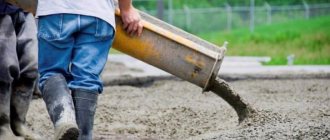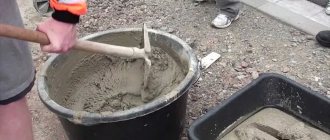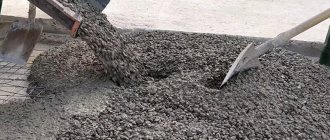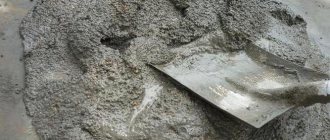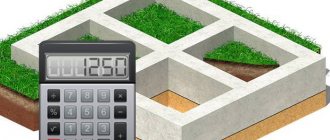Concrete M300 is a heavy type of concrete and can withstand heavy physical loads. Such concrete can be used for pouring the foundations of private houses, making paving slabs, stairs, piles, etc.
We have prepared step-by-step instructions for creating M300 concrete, indicating the proportions for preparing 1m3 of material. Any beginner can understand the instructions, even if he has no work experience or a concrete mixer.
Advantages of M300 concrete
M300 concrete has high strength, which is why it is in particular demand among builders. In addition, it has a number of other advantages:
- resistance to high and low temperatures (can withstand 150 periods of freezing and thawing);
- good moisture and fire resistance;
- optimal thermal conductivity;
- absence of toxic substances;
- the ability to add additives and plasticizers to improve the properties of concrete;
- optimal cost.
Characteristics of concrete M300
Concrete acquires its characteristics within 3-4 weeks after pouring. During this period, the water in it completely evaporates, and its cement-sand components are firmly bonded to each other.
Strength
This parameter affects all others and depends on the recipe of a particular mixture. The number 300 means that concrete remains intact under compression of 300 kg/cm2, but it is worth knowing that this number is average.
The M300 concrete marking is considered obsolete. According to the new standards, compressive strength is expressed using a grade. For this parameter, the English letter B is used with numbers that reflect the maximum loads that the concrete can withstand. Concrete class M300 corresponds to indicator B22.5.
Obtain concrete B22.5 M300 with a strength close to 300 kg per 1 sq. see, it is possible when using cement grade M400 or M500.
On the graph you can see how air temperature affects the accumulation of concrete strength. As the temperature increases, strength increases faster.
Density
One cube of M300 concrete can weigh 1800-2500 kg. Such a large discrepancy is caused by the use of different fractions of crushed stone, which affect the density of the mixture. By replacing crushed stone with granite, you can get heavy concrete weighing 2300-2500 kg. Such concrete can be used in structures that require protection from frost and moisture.
The formation of air voids in concrete leads to a decrease in its density and strength. If concrete grade M300 has a cube weight of less than 1800 kg, then it is considered defective.
Frost resistance
The frost resistance indicator indicates how many freeze-thaw cycles the M300 concrete grade can withstand. This characteristic is designated by the letter F. Concrete M300, made according to the classic recipe, has frost resistance F150, i.e. can freeze and thaw 150 times without loss of strength indicators.
Frost resistance can be increased to F200 through the use of special additives and the use of a vibrator to remove air voids. A decrease in frost resistance occurs due to the use of expanded clay or lime gravel.
Frost resistance of concrete can be increased using additives
Moisture resistance
Water resistance indicates the maximum value of water pressure that a concrete wall 15 cm thick can withstand. It is designated by the letter W and for concrete M300 it is W5-W6. Moisture resistance can be increased by adding special additives or using hydrophobic cement.
Mobility
Mobility (workability) reflects the fluidity of the concrete mixture and is at the level from P4 to P5. To fill the formwork, it is better to use a flowable mixture; it will easily fill the entire space around the reinforcement. Rigid mixture is more difficult to lay, but it is less susceptible to cracking or shrinkage.
Mobility is increased by using plasticizers or changing the amount of water in the solution.
Description of the main characteristics of the concrete mixture
M300 takes a long time to gain maximum strength. The solution will take about 6 months to reach its highest level, but 95-98% of its changes occur in the first 3 weeks. The properties and technical characteristics of liquid concrete can be strengthened or weakened with specialized additives.
Averages:
- strength class – B22 (290 kgf/cm²);
- frost resistance – F150-F200;
- water resistance – W8-W10;
- mobility – P1-P4.
By pouring a solution 10 mm thick, a consumption of 20-25 kg per square meter is obtained. You can test the strength of a frozen monolithic structure with the weight of an average person after 8 hours at an air temperature of +20.
Area of use
High levels of strength, frost resistance and water resistance determined the scope of application of class B22.5 concrete of grade M300. It is used in industrial and home construction to build durable structures. It is used for:
- pouring the foundation: strip, slab, pile-grillage;
- creating garden paths and paving slabs;
- reinforced concrete structures and partitions;
- pillars, piles and wall blocks;
- swimming pool construction;
- highways and areas for cars.
This is not the entire list where M300 concrete can be used. It is very popular in the construction of country houses, cottages, outbuildings and garages. It is also relevant when pouring heated floors.
Advantages and disadvantages
Advantages of liquid concrete mixture heavy BST grade M300 certified by GOST:
- Good strength and strength characteristics.
- Thermal conductivity.
- Durability.
- Moisture resistance.
- Safety.
- Resistant to aggressive environments and harsh weather conditions.
- Low cost.
BST brand M 300 is a universal building material that has a fairly wide range of applications due to its high performance and technical characteristics. Purchasing a solution prepared at the factory does not require additional preparation. The mixture is saturated with excipients at the request of the customer.
Composition of concrete M300
The main binder is Portland cement. When creating the mixture, you need to adhere to the correct ratio of cement, filler and sand. Only in this case will it be possible to achieve the required strength characteristics.
Crushed stone and gravel
To ensure the homogeneity of the concrete mass, you need to take crushed stone with different fractions: large, small and medium. They need to be added in equal proportions. This will avoid the formation of large voids.
If you use only fine crushed stone, the concrete will be more fluid, but cracks may form on it. Large fractions, on the contrary, will make it more durable. For M300 concrete, you can use lime, granite and crushed rock.
The size of the granite fraction in class B22.5 concrete when creating concrete roads and bridges reaches 5-20 mm, in the industrial sector 40 mm, and in large structures 40-70 mm.
When creating a mixture, crushed stone must be clean, free of dust and foreign materials, such as clay. Dirty deposits on crushed stone reduce strength, so dirty crushed stone must be washed and dried before use.
Sand
To prepare M300 concrete, fine river sand is added. Grains measuring 5-10 mm should not exceed 5% of the total volume of sand. Very fine sand is also not needed, since it is more like dust and has a negative effect.
When using quarry sand, it is first washed to get rid of silty impurities or clay. Sand can also be additionally sifted through a sieve.
Water
Based on the requirements of GOST 23732-2011, water for making the solution should not contain chemical impurities and acids. It is better to use water from a deep well, but sewage or swamp water cannot be used.
The more water there is in the concrete mixture, the lower the strength of M300 concrete will be. In the standard recipe, the volume of water should be 40-70% by weight of cement. This amount of water will allow you to get plastic concrete. When pouring the foundation, add 70% water.
Additives improve concrete performance
Supplements
Additives and plasticizers are usually not added to M300 concrete. They are needed only as needed to increase the strength class and other characteristics. For example, hydrophobic additives can be added to the foundation concrete if the future structure will be used in an area where groundwater flows.
Additives come in the following types:
- plasticizers – improve mobility;
- mineral powders and slags, reducing filler costs;
- calcium chloride, which promotes rapid hardening of the mixture.
Production of ready-mixed concrete in a factory
A concrete plant in Moscow allows you to mix raw materials absolutely accurately and in the right proportions and obtain high-quality mixtures. Components:
- Cement is the main binder; the use of lower grades or expired material is not allowed. The quality of the main component is a critical factor, so it must be tested by laboratory tests.
- Water is the second most important ingredient in the solution. Only purified liquid is used, without mechanical, chemical or biological additives. According to the state standard, the pH level is 4-12.5, the content of phenols and sugars is not higher than 10 mg/l.
- Crushed stone is a filler with fractions of 50-70 mm. A mandatory requirement is the absence of dirt and cracks. Limestone, gravel, granite are used.
- Sand of river or artificial origin of high density without foreign impurities. The grain size is 1-2.5 mm.
Recommendations for DIY production
In the case of large-scale construction, it is recommended to order the material at the factory, then it will arrive at the right time and in full accordance with the declared characteristics. To make M300 concrete with your own hands for home construction, you will have to prepare in advance and know the concrete recipe. The resulting solution can be used for the foundation for a garage, fence and other concrete structures in private housing construction.
Tools
The solution can be created using a concrete mixer and hand tools. Typically, the volume of a concrete mixer is chosen to be 60-120 liters. The choice of container must be based on the scale of work and available funds. If you don’t have a concrete mixer at hand, you can build a trough for mixing.
To make the mixture, you will need buckets, a shovel and a container for calculating bulk components.
Proportions of M300 concrete for preparing 1 m3 of material
The quality of the mixture is controlled by GOST 7473-94, which defines the technical requirements for concrete mixtures. It is possible to use cement grade M400 or M500 as a binder; only in this case can compliance with class M300 be achieved. The proportions of concrete per 1m3 may vary depending on the brand of cement used. Let's consider the consumption of materials and the composition of M300 concrete per 1 m3 in the table.
| The basis | Cement (parts/kg) | Crushed stone (parts/kg) | Sand (parts/kg) | Water (parts/l) | Volume of finished concrete, l |
| M400 | 1 / 382 | 2,8 / 1080 | 1,9 / 705 | 0.5-0.6 parts | 41 |
| M500 | 1 / 300 | 4,3 / 1290 | 2,4 / 720 | 0.5-0.6 parts | 47 |
When producing 1 m3 of M300 concrete in private construction, you will need 4 parts of crushed stone, 2 parts of sand, 1 part of M500 cement and 0.5 parts of water.
When choosing proportions, the following factors must be observed:
- method of laying the mixture into formwork - manually or using machinery;
- budget - to reduce cost, you can produce a low-grade solution in places where strength is not so important;
- operating conditions - when used on unstable soils, the grade of concrete must be increased.
Step-by-step instructions for preparing concrete M300
To find out the proportions in buckets of 1 cubic meter of concrete, you need to know the bulk density of all ingredients. For example, cement in a 10-12 liter bucket weighs 12-15 kg, sand - 15-17 kg, crushed stone - 15-17 kg. Knowing these numbers, you can easily measure all materials using one bucket. To do this, you need the number of kilograms in the required parts, divided by the number of kilograms that fit in the bucket.
When using a concrete mixer, it is important to adhere to the correct order of laying all components and achieve homogeneity of the mass. You need to use different buckets for sand and water so that the sand does not stick to the walls.
The mixture must be prepared immediately before starting work, and in a volume in which it can be used within two hours.
The order of laying materials is as follows:
- pour the required amount of water into the concrete mixer;
- turn on the concrete mixer to moisten the walls of the concrete mixer;
- pour cement;
- after the formation of cement laitance, add sand;
- after 3-4 minutes, when all the contents have turned into a homogeneous mass, add crushed stone;
- add water if necessary.
The total time for preparing the mixture should not exceed 10 minutes, otherwise it may begin to dry out. The readiness of the solution is indicated by uniformity of color; the entire mixture becomes gray.
If it is not possible to find a concrete mixer, then you can make concrete at home even without a trough. Some builders call this method “pie”, since they have to make a mixture with filling. The sequence of actions is as follows:
- measure all ingredients using a bucket;
- mix sand and crushed stone together;
- make grooves into which to pour cement and mix everything again;
- Make a cone-shaped depression in the middle of the resulting mixture and pour water into it;
- Gradually pour the resulting mixture from the edges into the created depressions until the entire mass becomes homogeneous;
- mix the entire mixture thoroughly.
Mixing concrete using the “Pie” method
Correlation of classes and brands
When describing concrete grades and their characteristics, it should be mentioned that the scope of use of each of them is usually similar to the corresponding class. If you know these parameters, you can easily select a composition that will be suitable for a certain type of work. The relationship between classes and markings is prescribed in GOST. Taking into account accepted standards, the correlation table for popular types of building materials looks like this:
| Class | Strength, kgf/cm² | Brand | Usage |
| 65 | M75 | plaster mixtures | |
| V7.5 | 98 | M100 | stone for borders |
| AT 10 | 131 | M150 | stone for borders |
| V12.5 | 131 | M150 | stone for borders |
| B15 | 196 | M200 | laying floor screed |
| IN 20 | 261 | M250 | retaining walls |
| B22.5 | 294 | M300 | reinforced concrete slabs |
| B30 | 327 | M400 | bridge structures, airfields, hydroelectric power stations |
The concrete strength table posted above makes it clear that the strength properties of a building material directly determine its purpose. Therefore, the selection of brand and class is carried out at the project development stage, taking into account related factors and recommendations of specialists.
Author of the article
Dry concrete options
Many manufacturers of building materials recommend dry concrete mixtures to developers. Their second name is sand concrete. Such mixtures are packaged in bags of 25 or 50 kg. The cost of sand concrete will be higher than cement, but the developer will not have to buy and bring sand to the construction site.
When creating a solution based on sand concrete, you need to add gravel. Sand concrete is prepared by pouring it into water and stirring for 3-5 minutes. After this, the mixture can be used for work.
How do you use M300 concrete? We invite you to discuss in the comments and share your experience.


